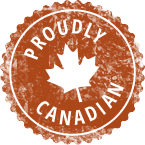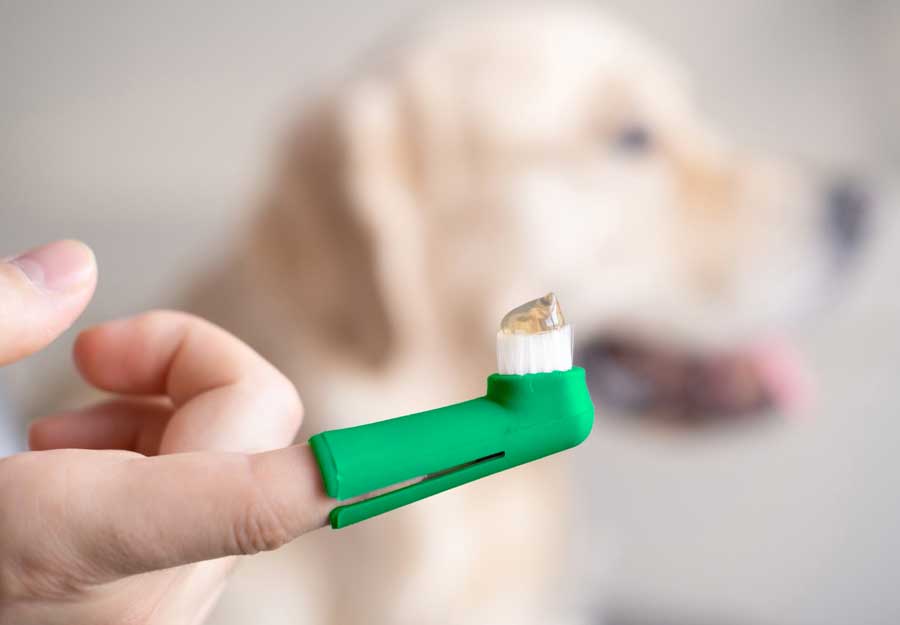
Does your dog have bad breath? Your dog's dental care routine may seem inconvenient but it plays a vital role in their overall health. Learn more about dog teeth cleaning and other dog dental care solutions.
Bad dog breath is one of the most common complaints for pet owners. Their stinky mouths can be quite off-putting for people and can put a real damper on puppy kisses. If your dog's breath is pungent then it's an indicator that their overall oral health is probably not great.
This can lead to further oral health issues, like tooth decay, abscesses, and infection. Poor dog dental health can also negatively impact your pet's health beyond their mouth, too, as bacteria from your dog's mouth can travel to and damage major organs, like their heart.
Dental health can affect many aspects of your pet's overall health, including digestion and immunity. Maintaining a consistent dog dental routine can have positive effects far beyond what goes on in their mouths.
Pet dental health is often not a priority until it’s too late and the damage is already done. Dental disease and the unexpected vet bills that are associated with poor dog dental health are preventable with the right tools and tips.
The Stats On Dog Teeth Cleaning (And Cats Too!)
Is poor dog dental care really that common? Do you really need to clean dog teeth? These dog dental stats prove that the answer to both of those questions is a resounding yes!
Did you know: According to the American Veterinary Medical Association (AVMA), almost 80% of dogs and 70% of cats are showing signs of dental disease by the ripe age of just three?
That’s pretty incredible, considering dental disease is preventable. Pet owners, according to the Veterinary Pet Insurance Co., spend a combined 11 million dollars per year on dental procedures. $11 million on something that is PREVENTABLE!
If we can make simple changes to improve our pet's dental care, then why are the statistics around pet dental health still so alarming?
Vet visits and regular cleanings are recommended, and they aren’t cheap, but a lot of that $11 million was on procedures to fix dental issues that could have been avoided if we spent more time keeping up with our pet's dental health in between vet visits.

The typical adult goes to the dentist twice a year for check-ups and cleaning or scaling. This process helps reduce the build-up that is difficult to remove at home.
What would happen if you didn’t brush your teeth, floss, or participate in any other dental routines in between your dentist appointments?
Obviously, your breath would be horrible, your teeth would rot, and all your friends would start keeping a generous distance from you. Of course, you keep yourself healthy by maintaining a regular dental routine, and this same line of thinking should apply to your pets as well.
Do I Need to Brush My Dog’s Teeth?
Yes. Oui. Da. Si. Evet. Hlja. Ok, that last one was Klingon, but you get the point. You need to brush your dog's teeth.
Brushing removes more bacteria than any other home dental procedure, so it’s an unavoidable necessity if you want a healthy dog. Oral bacteria hide well. It tucks itself under your dog's gum line, rests in between dog teeth, and even coats their tongue.
The scariest part is what bacteria can do below the surface. Periodontal disease is the decay and deterioration of the bone that holds the tooth. This can lead to teeth dying, breaking, chipping, and even falling out.
Unless you want a toothless dog, you’re going to need to commit to a regular dental routine for your dog.
Even worse, oral bacteria can sneak into the bloodstream via their gums. The blood can carry that bacteria to other areas of the body, which can lead to damage and infection in vital organs like the heart, liver and kidneys.
So why do we disregard the importance of our pet's dental health?
Well, there are many reasons and excuses that we use to avoid putting too much effort into our pet's teeth, but they all come down to the fact that we often don’t know how to care for them properly.
The good news is that there are lots of products and methods to help with dog dental care, but knowing which one works the best, how to do it, and which products will be best for your individual pet’s needs can feel quite complicated.
So, let’s ditch the excuses and dive into how to make your dog's dental health substantially better.
Bad Dog Breath Concerns

Getting rid of bad dog breath is often a multi-step process. It's not a quick fix, and it will take time and effort on your part to freshen your dog's breath. Fortunately, the long-term benefits of regular dog dental care will quickly outweigh the cost, and time you put into their dental health.
If your pet has offensive dog breath, this should tell you right away it’s time to start a dog teeth cleaning and oral care routine. Before getting into the solutions and best practices, learn a little about what causes dog breath:
Causes of Bad Dog Breath
Dog breath isn’t normal. Most pet owners have become accustomed to their pet’s nasty mouth odour and chalk it up to just being a dog.
This is true to some extent because dogs tend to put a lot of gross things in their mouth, but other bad breath contributors can be controlled, eliminated, or changed to improve your pooch's breath.
Let’s take a look at what’s causing your dog’s bad breath:
Plaque and Tartar
The foundation of bad dog breath is the build-up of food particles on teeth and gums and the resulting bacterial growth, called plaque. If this plaque is not removed from the teeth, over time it hardens and becomes calculus or tartar.
This tartar creates a rough surface that attracts more food particles and plaque, leading to even more tartar build-up. Tartar on dog teeth is much harder to remove than just plaque and often requires veterinary scaling. This is both costly for you and stressful for your pooch.
Dogs Eat Gross Stuff
As much as we would prefer they didn't, some dogs like eating nasty, smelly things, like garbage and poop. Is it gross? Ya. Should you try to prevent them from doing this? As best you can. Are they going to do it anyway? You betcha!
These unpleasant edibles are going to temporarily worsen your dog's breath, but the bacteria they leave behind may contribute to more long-term dog breath issues.
Indigestion and Food Intolerance
While not a primary cause of bad dog breath, indigestion and other gastrointestinal upsets can cause periodic bad breath in dogs. This happens when bacteria from the stomach and esophagus make their way back up to the mouth.
Chronic digestive illnesses can lead bacteria to frequently affect your dog's breath and their overall dental health.
Beyond Bad Dog Breath

You may think that bad breath is the worst that can happen if you don't brush your dog's teeth, but the reality is much worse. Poor dental health can lead to other health conditions that can easily go unnoticed until they become very serious.
Many serious health issues stemming from poor canine oral health are often caught way too late to fix, but it doesn't have to be this way. Bad breath is the engine warning light for your dog's oral health. If you notice changes to your dog's breath or a strong, unpleasant odour, it's time to talk to your vet to help you create a home dental care routine for Fido.
If you don't, you may end up dealing with much more serious and possibly life-threatening issues as your dog ages. Here are some of the more serious consequences of long-term, poor dental health in dogs:
Periodontal Disease
One of the most common long-term consequences of bad dog teeth is periodontal disease, which is also a major contributor to bad breath in dogs. Canine periodontal disease (a.k.a. gum disease in dogs, dog dental disease) starts when bacteria in the mouth cause the buildup of plaque and tartar along the gum line.
Bacteria then breed under the gums and begin to deteriorate supporting tissue and bone around the tooth. This will cause inflammation in the gums and lead to tooth decay. Your dog's immune system naturally kicks in and produces excess white blood cells to attack the bacteria and prevent infection.
Unfortunately, chemicals produced by the white blood cells cause additional damage to the supportive tissues of the tooth by causing inflammation in the periodontal space (between the tooth and gums).
This condition is referred to as periodontitis. If left for too long, the tooth will likely need to be extracted in an expensive dental procedure.
Heart, Liver, and Kidney Disease
Bad dog breath can be a sign of some very serious conditions. While these conditions are not the usual cause of bad breath in dogs, they are still worth noting. Some of these conditions, such as heart, kidney, and liver disease, can be caused by advanced periodontal disease.
Pay special attention if your dog:
-
-
- Has breath that smells sweet or like urine
- Has bad breath that is accompanied by difficulty in urinating, increased urination, lethargy or extreme tiredness, decreased appetite, profuse vomiting, yellow-looking gums
- Has any other unusual symptoms or extreme behavioural changes
-
If you are concerned that your dog may have a serious health issue, please consult a veterinarian.
When you allow bacteria to proliferate in your pet's mouth, they eventually make their way to the bloodstream, and then they can reach the liver, kidneys, and heart.
Severe dental disease has been linked to heart valve infections, heart murmurs, kidney disease that causes renal failure, and eventually even death.
This is why proper dental health and prevention of bad breath and periodontal disease in dogs are imperative! Now that you understand the importance of brushing your dog’s teeth, you're ready to learn how to get rid of bad dog breath solutions and keep those pearly whites clean.
10 Tips for How to Brush Your Dog’s Teeth
Brushing your dog's teeth is not fun, especially for your dog, but these tips can make the process a whole lot easier and less stressful for both of you. 
1. Pick the Right Time and Place
To reduce the fear and stress of brushing your dog’s teeth, make sure you choose a time and place where your dog can be as calm and relaxed as possible.
2. Find the Right Tools for Your Dog
Before you dive in, it’s important to understand your options and tools and how to use them appropriately to get the best result. Here are the most common and best products for cleaning dog teeth:
Many products can make doggy teeth cleaning easier and more effective. Don't be afraid to try a few different products to find out which will work best for your unique pooch.
3. Let Your Dog Taste Test
Dog toothpaste is often flavoured with chicken, beef, or peanut butter to make them more pleasant. To help your dog get used to the dog teeth cleaning tools, it’s a good idea to let him taste the toothpaste. Once they realize it’s tasty, they’ll be much more likely to let you brush their teeth.
4. Get Your Hands in There
This may not be the most fun part of the process, but a great way to help your dog get comfortable with this process is to practice touching his teeth and gums with your fingers. Start by gently lifting his lips, holding his jaw in place, and massaging his gums with your finger.
5. Introduce the Brush Slowly
Now that he’s okay with you fussing with his mouth, you can help to get him used to the toothbrush. Show him the dental tool, and let him sniff it. He needs to see that the brush isn’t going to hurt him. Put a small dab of the tasty toothpaste on the brush and let him lick it off. This will help him get used to the sensation of the brush.
When you are ready, start using both the toothbrush to gently massage his gum and front teeth in small circular motions. His front teeth will be the easiest to reach, so start there.
Here is a helpful video to help you learn the technique:
6. Work Your Way Back
Once you’ve practiced brushing the front and easy-to-reach teeth, begin to work your way further back. Focus on the outer side of the teeth, facing his cheeks. When you pull the lip up, some of the premolars will be exposed, so you can start to work in small circles further and further back.
7. Try Out New Positions
While sitting or standing are the most common positions to have your dog in, some teeth may not be accessible or easy to see from that angle. Try out some new positions, like having your dog lay on their side, to help you get a better view of what you’re doing.
8. Take a Break
This one is important for both of you. If you find yourself getting stressed or frustrated, or if your dog is losing patience with you, then it’s a good idea to take a break. This will give you both a chance to relax and try again later.
9. Practice, Practice, Practice
No one said it would be easy or fun, but with practice, you will both get better at this. Building the routine of brushing your dog’s teeth is important, so try not to give up. It will eventually get easier. A consistent dental care routine will improve your dog's health and breath!
10. Finish with a Reward
At the end of each tooth brushing session, no matter how successful, give your dog a reward for a job well done. Give him a toy, a belly rub, or take him for a walk to end the session on a good note. If your dog gets something he loves after each brushing, then he will be less nervous about the next time.
Some Dogs Hate Getting Their Teeth Cleaned
This shouldn’t come as a surprise, but most pets hate getting their teeth brushed. They fear what they don’t understand, and no matter how much they may trust you, their fearless leader, they are not going to enjoy you poking around in their mouths with a brush. Go slow, and be patient.
Over time, your pet will adapt to the routine, but only if you are consistent. Try different ways and methods of brushing to find the one that is the most manageable and least intimidating to your pet.
Choosing the Best Tools for Brushing Your Dog's Teeth
There are lots of different tools you can use to clean dog teeth and maintain their dental health. It's important to choose the tools that work best for your dog and make the process less stressful and the most effective.
Your dog's size, the shape of their mouth, comfort level, and their current dental health can all be a factor when choosing appropriate at-home dog teeth cleaning tools.
Here's a quick breakdown of each type of tool to help you decide:
Dog Toothbrushes
The style of toothbrush you choose can affect how much a struggle and how effective the whole process is. Size, shape, and style should be considered, and you should choose the one that works best for your dog's comfort level.
Traditional human toothbrushes are often too big and shaped wrong to effectively reach the nooks and crannies of your dog's mouth. Toothbrushes designed for dogs are typically angled and narrow to allow you to reach hard-to-reach spots.
If your dog is nervous about the toothbrush, then alternatives like a finger toothbrush are a great beginner tool. These rubber or microfibre finger covers allow you to gently massage teeth and gums and get your dog used to the process.
Wipes and swabs can also be used to practice brushing and reach difficult or sensitive spots.
If all else fails, you can start with just your finger and a little bit of tasty dog toothpaste. It won't be as effective as something with more scrubbing action, but it will help your dog acclimate.
Dog Toothpaste
Toothpaste is intended to reduce bacteria while you brush and is a wise choice when planning out your pet’s dental routine. Using toothpaste to brush your pet’s teeth is an effective way to minimize bad breath and prevent plaque and tartar build-up.
The first thing to know is that you should NEVER use human toothpaste on your pet. Toothpaste designed for people is dangerous for pets for two reasons:
-
- Human toothpaste is toxic to pets. Ingredients like xylitol are commonly used to sweeten toothpaste, and xylitol severely compromises animals' liver function.
- Human Toothpaste is a choking hazard for pets. Toothpaste for people contains surfactants or foaming agents. You and I know not to breathe in the foam while we are brushing, but your pet definitely doesn’t.
Thankfully, there are many pet-specific products available, so always choose one of those when using tooth cleaning products in your pet’s dental care.
When choosing a toothpaste or another dental cleaning product for pets, make sure it is appropriate for their species, dog vs cat, and is specifically labelled as an enzymatic toothpaste.
To learn more about what kind of dog toothpaste to choose, hop over to Best Dog Toothpaste for Bad Breath.
Dog Tooth Sprays, Foams, or Gels
Products in the form of gels, foams, or sprays can also help to clean dog teeth and freshen their breath. When applied directly to the gums and teeth or on the underside of the cheeks, gels and sprays work in a similar way to mouthwashes. Here are some great brands that are effective and easy to use:
Your pet tries to lick the product off, spreading the oral cleaner around his or her mouth. For more severe build-up, massaging the gel/spray onto their teeth with a finger toothbrush or just your finger will produce more effective results.
Dog Teeth Wash

A dog teeth wash, or water additive, is an easy-to-use tool for bacteria control throughout the day. A small amount of the liquid gets added to your pet's water bowl or fountain. As they drink, the solution is moved around their mouth, distributing the dental effects.
When choosing a dental solution, try finding products that contain natural bacteria fighters, like parsley, mint, or chlorophyll. These will be very effective at combating bad breath by reducing the number of bacteria. Products like Tropiclean Fresh Breath are essentially mouthwash for pets, which works great in conjunction with regular tooth brushing routines.
This type of product is not for instant gratification seekers. When we said long-term, we meant it. It can be disappointing not to see the fruits of your labour for weeks or even months, but the product will be effective over time.
Water additives are not always an ideal choice for every pet. Cats, for example, generally don’t drink nearly enough water, as they are instinctually built to get moisture from their diets. For pets that just don’t drink enough, the effects will be significantly muted and possibly completely ineffective.
Another factor to consider that may affect the efficacy of a water additive is the cleanliness of the bowl or dish in which the water is offered. Water bowls should be cleaned weekly to prevent bacteria build-up.
Plastic or rubber bowls should be exchanged for metal, ceramic or glass to prevent further bacteria that can fester in the cracks and scratches of the material.
Dental Food Additives for Dogs

For a different approach that may be more effective for our less-hydrated pets, try a food additive. Similar to water additives, these flavourless, odourless powders can be added to their meals, and they do the rest of the work for you.
Probiotics, like Buco+ Dental Care, are chalked full of healthy oral bacteria to help populate the mouth and overpower the harmful bacteria, stealing its food source and making your dog's mouth an inhospitable environment for bad breath-causing bacteria.
This is an effective way to prevent plaque build-up and bad breath. Simply add the recommended amount of Buco+ to your pet's food, and as they eat, they will naturally circulate the healthy bacteria around their mouth.
Another very effective food additive is Proden Plaque-Off. Plaque-Off is not a bacteria. Instead, it works with your pet's saliva to coat the mouth and break down plaque build-up over time, allowing you to brush the softened plaque away.
They claim that once mixed with your pet's saliva, it will continue to work long after the meal is over, providing 24-hour effectiveness.
Proden Plaque-Off powder is made of Norwegian sea kelp, so it is all-natural and safe to ingest. We recommend this product for pets that have an existing build-up of plaque.
When used in combination with regular toothbrushing, Plaque-Off is extremely effective for reducing build-up and improving your pet's bad breath.
Best Dog Food for Dental Health
The food you feed your dog can significantly affect their dental health. If you are trying to combat bad dog breath or improve your dog's dental health, a common food to start looking for is dental care dog foods. These diets are often designed to encourage chewing and contain bacteria-fighting ingredients.
Dental kibbles are usually large bites, so dogs that tend to swallow smaller kibbles whole will be more likely to chew the kibble and get the benefit of the dental food texture.
Natural breath-freshening ingredients, like green tea extract and parsley, are often used in combination with tartar-reducing agents like sodium hexametaphosphate to keep breath fresh and hard to remove buildup on the teeth.
Of course, dental dog food alone will not be a sufficient dental care routine, but they can be one piece of the puzzle.
Kibble Isn't Always the Best
It's also important to note that dental kibbles don't work for every dog. Dogs who eat too fast and don't bother chewing properly, will not receive the dental benefits.
Additionally, kibble can leave more residue than it removes. Carbs are a large portion of most kibbles as they are structurally significant to give kibble its crunchy texture.
Left behind food debris will feed bad breath-causing bacteria, and can further contribute to dental issues, especially if you don't pair their food with a solid and consistent dog teeth cleaning routine.
Slow-feed bowls may help encourage chewing and increase the effectiveness of dental kibbles, but they will not eliminate or reduce the need for a doggy dental routine.
Best Dog Food for Dental Health
One of the best types of diet for dental health is a raw diet. Whether it is dehydrated, freeze-dried, or frozen, raw meat contains enzymes that aid in the breakdown of oral bacteria. Even if there is very little chewing going on, these diets still provide superior dental care to kibble.
If raw diets aren't for you, then stick to minimally processed, high-quality foods. Feeding a dehydrated or freeze-dried diet, like Primal, will still be a better alternative than kibble or canned diets. Look for a diet with fewer carbs that uses fresh, wholesome ingredients.
Recommendations:
Ingredients matter too. Heavily processed, sugary ingredients feed bacteria, intensifying the problem and increasing build-up near the gum line. Look for low-carb and low-glycemic options to minimize the number of sugars passing through your pet's mouth.
Kibble is a very high-carb format compared to raw, so if you’re feeding a dry dog food, try incorporating raw or fresh foods into your pet's daily routine to help limit carb intake and increase the positive dental effects.
Best Dental Treats for Dogs
Additional dental care products, like treats, can enhance daily dental routines and be a rewarding experience for your pet. Treats designed for dental health contain ingredients like mint, parsley, and chlorophyll to freshen breath and reduce harmful bacteria.
Dog teeth treats can be a simple addition to any dental routine, but depending on the ingredients and calories, they might not be suitable for pets with allergies, digestive issues, or weight problems.
Dog Dental Biscuits
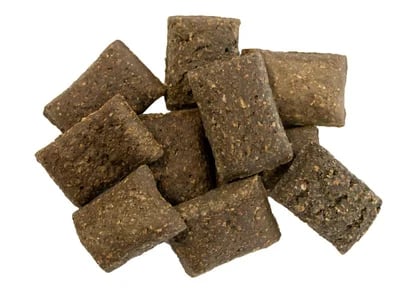 Biscuits are a typical format for dog teeth treats. Geared towards freshening breath, biscuits have similar effects to some water additives. Treats can be fed regularly and are easy to incorporate into some existing treating routines, like treat training and rewarding good behaviour.
Biscuits are a typical format for dog teeth treats. Geared towards freshening breath, biscuits have similar effects to some water additives. Treats can be fed regularly and are easy to incorporate into some existing treating routines, like treat training and rewarding good behaviour.
Here are some of our favourites:
While biscuits do have their benefits, just like kibbles, they can be full of carbohydrates and sugars that can feed bad breath-causing bacteria. They can also leave residue between teeth and along the gum line, furthering the point that nothing replaces the benefit of brushing your pet’s teeth.
Dog Dental Chews
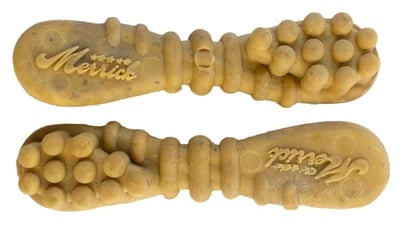 Dental Chews are another common dog teeth cleaning treat format designed to create abrasion through repetitive chewing. While there are many types of dental chews available, they will typically be either hard to encourage chewing or soft enough for your pet’s tooth to sink into it while the treat holds its structure.
Dental Chews are another common dog teeth cleaning treat format designed to create abrasion through repetitive chewing. While there are many types of dental chews available, they will typically be either hard to encourage chewing or soft enough for your pet’s tooth to sink into it while the treat holds its structure.
Dog Dental Sticks are designed to help scrape away loose bacteria and debris from the teeth and gum line. They also include breath-freshening ingredients like seaweed, coconut oil, and mint to further curb your dog's bad breath. Check out some of our most popular dental chews and bones for dogs.
Natural Chews for Dogs
 An often overlooked treat for dental health is natural chews. When talking about the effectiveness of dental treats, the focus is on chewing, which is the primary purpose of natural chews. They not only provide a rewarding activity, but they work the jaw and help remove bacteria and food debris.
An often overlooked treat for dental health is natural chews. When talking about the effectiveness of dental treats, the focus is on chewing, which is the primary purpose of natural chews. They not only provide a rewarding activity, but they work the jaw and help remove bacteria and food debris.
Unlike dental treats and sticks, natural chews are meant to be long-lasting. They don’t contain bacteria-fighting ingredients, but many of them soften and can slink between teeth to remove bacteria and food particles, similar to flossing. Beef tendons and bully sticks both share this quality.
Smaller dogs and cats can benefit from natural chews too. Raw frozen Chicken Feet, Lamb Ears, and even dried Salmon Skins can offer a similar scrape and floss as bigger chews.
Best Dental Toys for Dogs

The last method of dental care is toys. Yes, toys can help clean your pet’s teeth! Not every toy works for this purpose, but many toys intended for chewing are an excellent way to improve your pet’s dental health in a fun and enjoyable manner.
Some toys are specifically designed for dental health, like Benebones. Rubber toys, like the Petstages Orka Puppy Dental Chew, will massage gums and help remove bacteria and food residue.
These toys can even be combined with a small amount of flavoured pet-safe toothpaste to encourage your dog to chew. This won't replace toothbrushing, but it can contribute to better overall dental health in your dog.
Another great way to utilize dog toys for dental health is to choose textured dog toys and apply a small amount of dog toothpaste or coconut oil. This turns your dog's favourite chewy into a toothbrush. It won't replace an actual toothbrush, but it is a great way to supplement weekly dog teeth cleaning routines.
Benefits of a Dog Teeth Cleaning Routine
Dental care is multi-faceted, and immediate results are rare. This can be frustrating, especially when you are trying multiple methods, and significant results could take weeks or even months to recognize. Look for small changes to tell if your pet’s dental health is improving.
Here are some subtle signs that you are on the right track:
Improved Breath

No one is expecting their pet’s breath to smell good, but seeing an improvement in how bad it can smell is an excellent sign. Better breath means that there is a reduction of harmful bacteria circulating in their mouths, and this can prevent plaque and tartar build-up, which can lead to other serious illnesses and diseases in the future.
Better Eating Habits
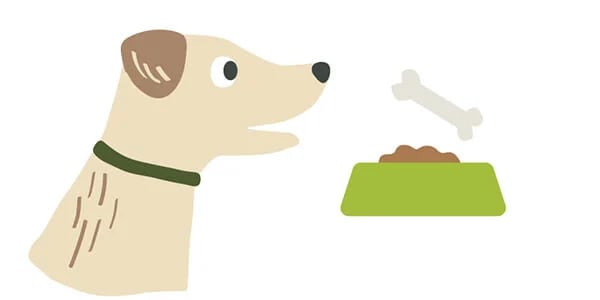
Anyone who has ever experienced dental pain can attest to the fact that how you chew can be affected by your dental health. Something as minor as tooth sensitivity or gum tenderness and inflammation can change the way your pet eats.
As your new dental routine becomes a priority, your pets who don’t chew, might start. Pets who typically skip meals or aren’t interested in food may suddenly have an increased appetite.
Pets who refuse to eat hard foods or treats may begin to show an interest in kibble or natural chews. All of these can be signs of improved dental health.
Improved Overall Health
.webp?width=600&height=300&name=improved-health%20(1).webp)
Dental bacteria can affect more than just the mouth. Bacteria that hide under the gum line can be transported through the bloodstream and have an effect on organ function, commonly the heart.
Poor oral health is thought to be directly linked to some heart diseases. It doesn’t stop there, other organs can also be affected, like your pet’s liver or kidneys. This is due to their body's natural response to bacteria ending up where it shouldn’t be, inflammation.
The inflammation can restrict blood flow which has a significant effect on organ function. All of these vital organs aid in digestion, immunity, and energy levels. Therefore, improvements in weight, activity, and stool quality are all indicators that your pet’s oral health is on the rise.
If you’re concerned that your pet is suffering from ailments concerning their dental health, you need to talk to your vet. Infection can spread quickly, so delaying can lead to more serious health issues down the road.
Take Control of Your Dog's Dental Health

In the long run, we desire to see perfectly white, healthy teeth, but depending on the severity of your pet’s current dental health, that may be a tough goal to accomplish. Work with your vet to determine the best methods for your pet’s situation, and be patient.
These things take time and practice. Don’t give up!
You may not even be aware of how impactful your dental practices are. The subtlety of the improvements may make it harder to see the light at the end of the tunnel, but in the end, you will achieve better quality, and possibly even quantity, of life for your pet.
Our final note is that none of the alternative dental procedures that were addressed in this blog will replace regular vet visits and brushing your pet’s teeth daily.
You may hate doing it, and trust us, your pet probably hates it too, but it has to be done.
Talk to your vet about getting a dental assessment to determine the right course of action. A simple dental cleaning may kick-start your progress and help you stay on top of your pet’s dental care.
Dog Dental Care & Teeth Cleaning FAQs
What is the best dental care for dogs?
There are many methods of caring for your dog's teeth, but the best dog teeth-cleaning solution is tooth brushing. Other maintenance methods and dog dental care products can complement regularly brushing your dog's teeth but will never replace it.
What's the best way to clean dog teeth?
Brushing your dog’s teeth is the best dental care for dogs. There are tons of alternative products to help improve dog dental health, but none of them compare to good old-fashioned tooth brushing.
How often should you be cleaning your dog’s teeth?
In a perfect world, you should be brushing your pet's teeth every day. In an even more perfect world, after every meal. Short, 1-2 minute brushing sessions will make a huge difference in overall dental health. We know that that seems like a lot, so start with once per week and work towards getting as close to every day as you can.
Can I use other dental products to avoid toothbrushing?
The short answer is no. The long answer is that although nothing will replace tooth brushing, many dental products are great for enhancing a dental routine, especially when tooth brushing sessions are a bit of a struggle.
How early can I start brushing my pet's teeth?
As soon as they have teeth, you can start caring for them. Obviously, those fresh baby teeth are going to be very healthy already, so the best dental care for puppies is less about cleaning and more about building the routine and making future dental care much more relaxed.
Can diet affect dental health?
Absolutely! Some diet formats and ingredients can create more dental problems than they solve, and some are considerably less effective than you think. Kibble diets are often seen as a dental solution, but for many dogs, these starchy foods leave behind more food debris than they clean.
.png?width=200&height=66&name=logo%20(1).png)





.jpg)
